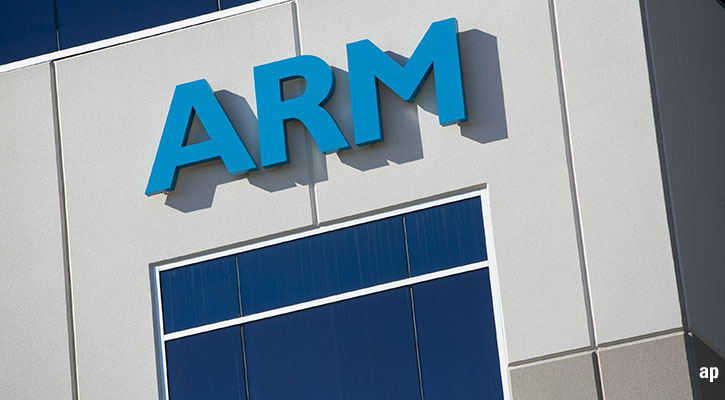
Arm Holdings (ARM) released its fiscal first-quarter earnings report on July 31. Here’s Morningstar’s take on Arm’s earnings and stock.
What We Thought of Arm's Earnings
• Arm’s revenue came in at $939 million, compared with management’s guidance of $875 million-$925 million for the quarter, while adjusted earnings per share was $0.40, compared with guidance of $0.32-$0.36. However, this wasn’t enough to satisfy investor demands, and the stock was down 12% in aftermarket trading to about $126 per share. Revenue growth is being driven by the adoption of the firm’s v9 architecture.
• Although management already expected the next quarter to be the low of the year due to the timing of license revenue, its $780 million-$830 million sales guidance was dimmer than anticipated. Management also moderated its yearly targets slightly and expects royalty revenue growth in the low-20% range, compared with mid-20% previously. Like with other tech stocks, we surmise investors were expecting a beat and raised guidance to justify Arm’s lofty valuation.
• Nothing has changed our view that Arm is overvalued and has no margin of safety.
Key Morningstar Metrics for Arm
• Fair Value Estimate: $66
• Morningstar Rating: ★
• Morningstar Economic Moat Rating: Wide
• Morningstar Uncertainty Rating: High
Fair Value Estimate for Arm
Our forecasts are unchanged, and we maintain our fair value estimate of $66 per share. We estimate Arm will reach a blended royalty rate of around 5% in 2030 and 6% in our terminal year, 2034. The firm’s newest architecture, v9, carries double the royalty rates of its predecessor, v8.
We estimate royalty rates for v9 are 4%-5%, compared with the 1.7% blended rate the firm reported in its IPO filing for 2022. V9 adoption keeps increasing, mainly from adoption in high-end smartphones and the data center, and management sees increased adoption in the next few years. Our fair value estimate represents an adjusted price/earnings ratio of 44 times in fiscal 2025 and 35 times in fiscal 2026.
Arm's Economic Moat Rating
We assign Arm a wide moat based on intangible assets and switching costs. Arm is the IP owner and developer of the ARM (Acorn RISC Machine) architecture, which is used in 99% of the world’s smartphone CPU cores. The firm also has a high market share in other battery-powered devices, like wearables, tablets, and sensors.
Arm architecture is known for its optimal design for battery-powered devices, which is simpler and consumes less power compared with Intel’s x86 architecture. x86 has traditionally been associated with higher computational performance at the expense of increased power consumption, making it ideal for PCs or data centers. In contrast, Arm architecture consumes less energy but tends to offer less computational power, making it ideal for battery-powered devices. For years, the two architectures have been striving to meet in the middle.
Financial Strength
We think Arm is financially healthy, with $1.6 billion of cash on hand and no debt. According to its IPO filing, the firm does not intend to pay any dividend on its ordinary shares. We also don’t expect any significant M&A, as Arm would probably face antitrust scrutiny in any mid-sized or large deal, given its high market share. In the past five years, the firm has made several minor equity investments in semiconductor startups that it could sell if it needs cash.
Risk and Uncertainty
We give Arm a High Uncertainty Rating, with key risks coming from China and the slow but steady adoption of RISC-V architecture.
More than 20% of Arm’s business comes from China. Arm China is the only entity allowed to sell its IP in the country, but the company does not control Arm China. Rather, Arm licenses IP to Arm China, which sublicenses it to Chinese customers like Xiaomi or Huawei. Arm’s revenue recognition from the country depends on the information Arm China provides, and financial reporting controls there have historically been weak. SoftBank, Arm’s main shareholder, still has significant influence over Arm China. There could be attempts to steal intellectual property from Arm China, given the geopolitical tensions between the United States and China.
Although RISC-V chips can’t currently match Arm in performance, power efficiency, and ecosystem support, the architecture is slowly but steadily gaining adoption. RISC-V is open source, saving costs for startups and adding flexibility on the design. On the other hand, Arm provides a faster time-to-market (as it sells off-the-shelf blueprints) and better customer support, given it is backed by a single company. We don’t see Arm’s architecture being challenged by RISC-V in the next 10 years, but beyond that, RISC-V could gain market share.
Arm Bulls Say
• We expect Arm will keep gaining market share in the data center business from x86 architecture, as its chips consume less power and data centers need to minimize their energy consumption. We also expect share gains in the automotive segment, thanks to the transition to electric vehicles.
• The overall trend toward the Internet of Things and battery-powered devices is a long-term tailwind for Arm, as it has the most energy-efficient architecture.
• If Arm changes its business model to charge royalties on a per-device basis, this would provide huge revenue and margin upside.
Arm Bears Say
• If Arm manages to charge royalties on a per-device basis, or if it were to meaningfully increase its royalty rates per chip, it could become a double-edged sword. Too much royalty revenue may encourage customers to adopt open-source RISC-V instead.
• Arm China is one of Arm’s largest clients, representing more than 20% of revenue. Its financial reporting has historically been opaque, and there could be attempts to steal Arm’s intellectual property.
• Arm’s revenue concentration is very high, with its top five customers representing close to 60% of sales.
• This article was compiled by Leah Breakstone





















